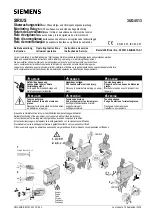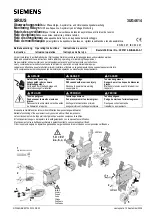
Date Code 20010731
Distributed Network Protocol (DNP) 3.00
G-11
SEL-352-1, -2 Instruction Manual
DNP Object Type
Index
Description
30, 32
62–67
Resistor heat Open & Close A, B, C.
30
30
68
69
Event Type (see Event Cause table, next page).
Fault frequency.
30 70–75
Voltage Nulling Factor (All Phases, Mag. & Angle).
30
76
Fault settings group.
30 77–79
Fault time in DNP format (high, middle, and low 16 bits).
40,41
00
Active settings group.
Binary inputs (objects 1 and 2) are supported as defined by the previous table. Binary inputs
0–799 and 1600–1619 are scanned approximately once every 128 ms to generate events. When
time is reported with these event objects, it is the time at which the scanner observed the bit
change. This may be significantly delayed from when the original source changed and should
not be used for sequence-of-events determination. In order to determine an element’s point
index, see the
Binary Input Lookup Table
. It is derived from the Relay Word Bits tables in
Appendix F: Relay Word
. Locate the element in question in the table and note the Relay Word
row number. From that row number, subtract the row number of the first Relay Word row
(usually 2) and multiply that result by 8. This is the index of the right-most element of the Relay
Word row of the element in question. Count over to the original element and add that to get the
point index. Binary Inputs 800–1599 are derived from the Sequential Events Recorder (SER)
and carry the time stamp of actual occurrence. Add 800 to the Binary Input Point column to get
the point mapping for points 800–1599. Static reads from these inputs will show the same data
as a read from the corresponding index in the 0–799 group. Only points that are actually in the
SER list (SET R) will generate events in the 800–1599 group.
Analog Inputs (objects 30 and 32) are supported as defined by the preceding table. The values
are reported in primary units. Current magnitudes are scaled according to the DECPLA setting.
If DECPLA is 3, then its value is multiplied by 1000. Similarly voltage magnitudes and VDC
are scaled according to the DECPLV setting. All other quantities are scaled by the DECPLM
setting. Event-class messages are generated whenever an input changes beyond the value given
by the ANADBA, ANADBV, or ANADBM settings. The dead-band check is done after any
scaling is applied. Analog inputs are scanned at approximately a ½-second rate, except for
analogs 68–79. During a scan, all events generated will use the time the scan was initiated.
Analogs 68–79 are derived from the history queue data for the most recently read fault and do
not generate event messages. Analog 68 is defined as follows:
Summary of Contents for SEL-352-1
Page 8: ......
Page 10: ......
Page 12: ......
Page 30: ......
Page 68: ......
Page 186: ......
Page 292: ......
Page 302: ......
Page 368: ......
Page 370: ......
Page 374: ......
Page 380: ......
Page 382: ......
Page 384: ......
Page 386: ......
Page 396: ......
Page 404: ......
Page 422: ......
Page 442: ......












































